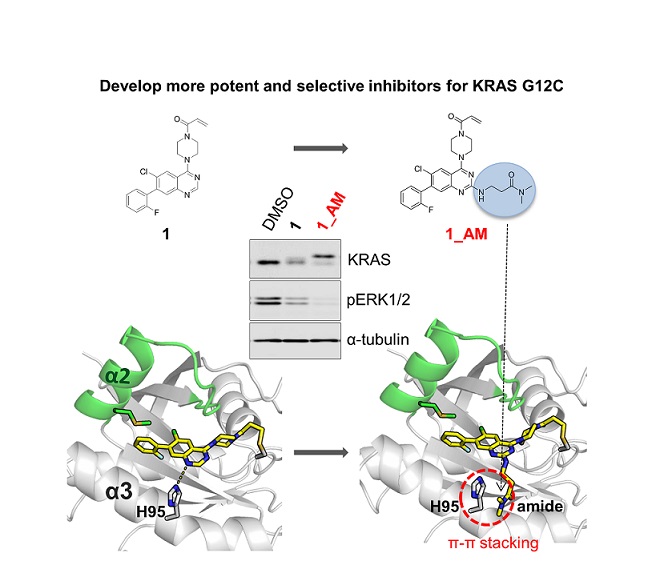Lung Cancer



Posted July 10, 2018
Kenneth Westover, M.D., Ph.D., University of Texas Southwestern Medical Center

Dr. Kenneth Westover
One of the most prevalent forms of lung cancer is lung adenocarcinoma, often caused by mutations in codons 12, 13, or 61 of the KRAS gene and result in constitutive activation of KRAS and oncogenesis. The predominant KRAS mutation in lung adenocarcinoma, common in individuals with a history of smoking, is mutation at codon 12 changing a glycine to a cysteine (G12C) and is found in approximately 25,000 new cases of lung cancer annually (Downward, 2003). Because of its role in oncogenesis, KRAS is considered a therapeutic target; however, it is difficult to directly target RAS, a GTPase, with small molecules due to strong interactions between cellular GTP and KRAS (Cox, Fesik, Kimmelman, et al., 2014). Small-molecule compounds (e.g., MEK and ERK inhibitors) targeting prominent KRAS downstream pathways show minimal clinical efficacy in KRAS mutant lung adenocarcinoma.
With support from a fiscal year 2015 (FY15) Lung Cancer Research Program (LCRP) New Investigator Idea Development award, Dr. Kenneth Westover from University of Texas Southwestern Medical Center studied the interactions between KRAS and potential therapeutic small molecule inhibitors. His team studied analogues of SML-8-73-1, a high selective, GTP-competitive inhibitor that inactivates KRAS when bound to G12C developed by Dr. Westover and Dr. Nathanael Gray of Dana Farber Cancer institute in an effort to make compounds that could efficiently enter cells (Hunter, Gurbani, Ficarro, et al., 2014). Drs. Westover and Gray also explored a quinazoline-containing class of switch II pocket (SIIP) inhibitors that target an allosteric regulatory site, similar to compounds originally reported by Drs. Shokat and Wells of University of California, San Francisco. Drs. Westover and Gray demonstrated that addition of amino amide and hydroxynaphthyl substituents to the quinazoline compounds improved KRAS binding potency and resulted in enhanced anti-proliferative and pro-cell death effects in cancer cell lines in a KRAS G12C-dependent manner. These results, reported in Cell Chemical Biology (Zeng, Lu, Li, et al., 2017), demonstrate the potential of quinazoline compounds as tools for the study of KRAS G12C-related biology and as therapeutic candidates.
Results from the LCRP funded work also inspired a collaboration with Dr. Pasi Jänne at the Dana-Farber Cancer Institute to examine the role of RAS dimerization on the tumor suppressive effects of wildtype RAS in cancer cell lines, a phenomenon previously described by others but poorly understood mechanistically (Singh, Sowjanya, and Ramakrishna, 2005). Drs. Westover and Jänne created a dimerization-deficient KRAS D154Q mutant to investigate the role of wildtype KRAS dimerization in tumor suppression.
An in vivo analysis using nude mice xenografts from A549 and H2122 human lung cancer cells with either wildtype or D154Q mutant KRAS demonstrated that tumors expressing wildtype KRAS grew significantly slower when compared to tumors with the D154Q mutant. When the tumors were treated with Selumetinib, a MEK inhibitor, wildtype KRAS tumors exhibited resistance to the treatment, whereas KRAS D154Q tumors did not have altered sensitivity compared to controls. Introduction of the D154Q mutation into cells with other oncogenic G12 mutations resulted in severely impaired growth rates and increased levels of apoptosis when compared to cells with oncogenic G12 mutations alone. Critically, cells with simultaneous D154Q and G12 mutations were unable to form tumors in vivo whereas G12-only mutants readily did. This suggests that oncogenic KRAS activation of the MAPK pathway, one of the most prominent KRAS downstream pathways activated in cancer, is dependent on KRAS dimerization in vivo.
The results of Drs. Westover and Jänne's work, published in Cell (Ambrogio, Köhler, Zhou, et al., 2018), indicate that wildtype KRAS inhibits tumor growth by dimerizing with mutant KRAS, and that dimerization is critical for mutant KRAS oncogenic functions. Their discoveries could have clinical implications for cancer treatment planning in patients with KRAS mutations: one copy of the wildtype KRAS gene could act as a potential biomarker to select for patients that may be more sensitive to MEK inhibitor therapy.

Zeng et al. demonstrate that introduction of an amino amide substituent to the quinazoline scaffold remarkably increases the labeling efficiency and rates, potency, and selectivity of KRAS G12C inhibitors. This is supported by structural evidence that amide side chain allows additional interactions with KRAS G12C. Zeng et al. Cell Chem Biol 24(8):1005-1016.
Publications:
Ambrogio C, Köhler J, Zhou ZW, Wang H, Paranal R, Li J, Capelletti M, Caffarra C, Li S, Lv Q, Gondi S, Hunter JC, Lu J, Chiarle R, SantamarÃa D, Westover KD, and Jänne PA. 2018. KRAS dimerization impacts MEK inhibitor sensitivity and oncogenic activity of mutant KRAS. Cell 172(4):857-868.
Zeng M, Lu J, Li L, Feru F, Quan C, Gero TW, Ficarro SB, Xiong Y, Ambrogio C, Paranal RM, Catalano M, Shao J, Wong KK, Marto JA, Fischer ES, Jänne PA, Scott DA, Westover KD, Gray NS. 2017. Potent and selective covalent quinazoline inhibitors of KRAS G12C. Cell Chem Biol 24(8):1005-1016.
References:
Cox AD, Fesik SW, Kimmelman AC, Luo J, and Der CJ. 2014. Drugging the undruggable Ras: mission possible? Nat Rev Drug Discov 13(11):828-851. (https://www.ncbi.nlm.nih.gov/pmc/articles/PMC4355017/)
Downward J. 2003. Targeting RAS signaling pathways in cancer therapy. Nat. Rev. Cancer 3, 11-22. (http://www.nature.com/articles/nrc969)
Prior IA, Lewis PD, and Mattos C. 2012. A comprehensive survey of Ras mutations in cancer. Cancer Res 72(10):2457-2467. (https://www.ncbi.nlm.nih.gov/pmc/articles/PMC3354961/)
Le Calvez F, Mukeria A, Hunt JD, Kelm O, Hung RJ, Tanière P, Brennan P, Boffetta P, Zardize DG, and Hainaut P. 2005. TP53 and KRAS mutation load and types in lung cancers in relation to tobacco smoke: Distinct patterns in never, former, and current smokers. Cancer Res 65(12):5076-5083. (http://cancerres.aacrjournals.org/content/65/12/5076.long)
Hunter JC, Gurbani D, Ficarro SB, Carrasco MA, Min Lim S, Geun Choi H, Xie T, Marto JA, Chen Z, Gray NS, Westover KD. 2014. In situ selectivity profiling and crystal structure of SML-8-73-1, an active site inhibitor of oncogenic K-Ras G12C. Proc Nat. Acad Sc. USA 111(24):8895-8900. (https://www.ncbi.nlm.nih.gov/pmc/articles/PMC4066474/)
Singh A, Sowjanya AP, Ramakrishna G. 2005. The wild-type Ras: road ahead. The FASEB Journal 19(2):161-169. (http://www.fasebj.org/doi/10.1096/fj.04-2584hyp)
Link:
Last updated Wednesday, March 19, 2025














